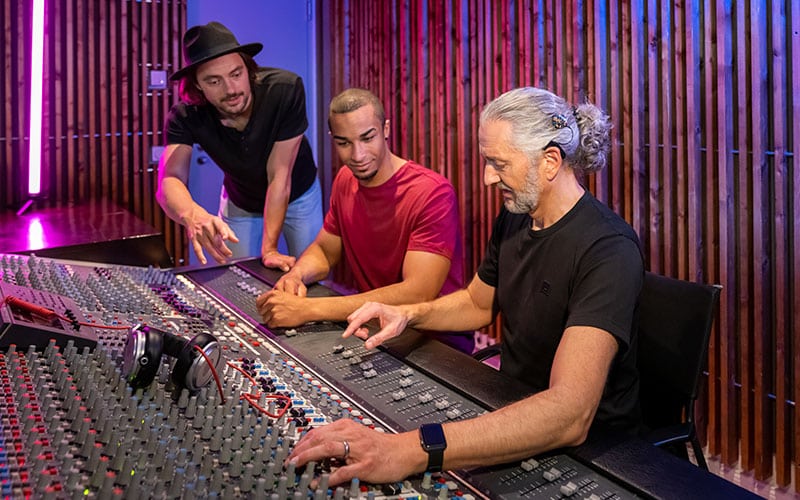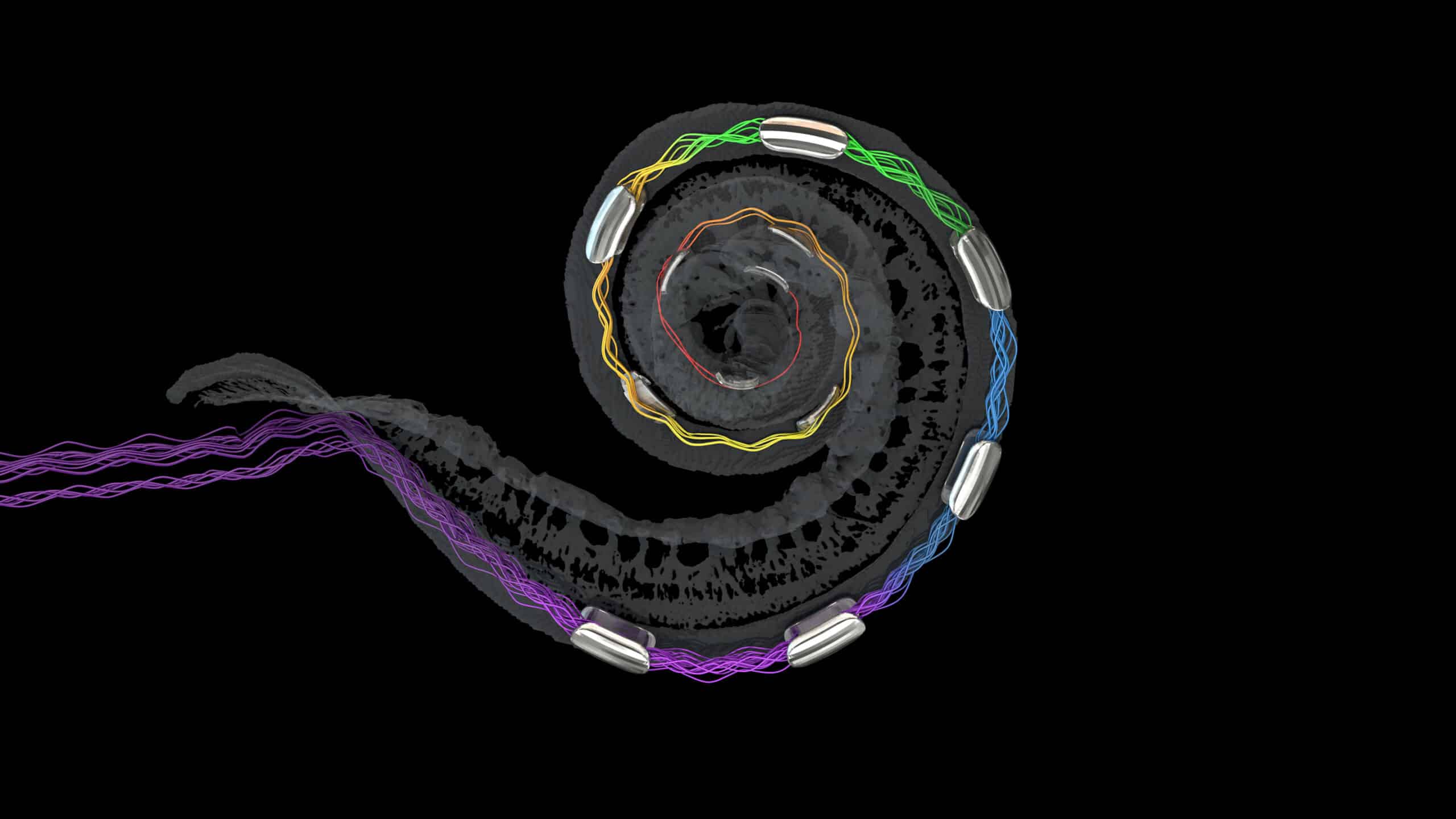
MED-EL
Published Nov 07, 2023
Music and Sound Quality With MED-EL Cochlear Implants, Part 2
In the first part of MED-EL’s story, we followed our quest to bring music enjoyment back to cochlear implant recipients. Even with poor sound quality, robotic-sounding speech, and cartoon-character voices, cochlear implant recipients were able to demonstrate good speech understanding scores, but they found music unpleasant to listen to.

The electrode insertion depth plays an important role in the natural coding of pitch alongside fine structure sound coding. Adjustment to robotic sound quality does happen over time and with practice, but whether the brain can ever truly overcome the large pitch gap that occurs from a short electrode inserted at a shallow depth has been in question for some time. These pitch conflicts often don’t completely resolve, even after years of listening practice. McDermott, H., Sucher, C., & Simpson, A. (2009). Electro-acoustic stimulation. Acoustic and electric pitch comparisons. Audiology and Neurotology, 14 Suppl 1, 2-7. doi:10.1159/000206489[1]Tan, C.T., Martin, B., & Svirsky, M.A. (2017). Pitch Matching between Electrical Stimulation of a Cochlear Implant and Acoustic Stimuli Presented to a Contralateral Ear with Residual Hearing. Journal of the American Academy of Audiology, 28(3), 187-199. doi: 10.3766/jaaa.15063. PMID: 28277210; PMCID: PMC5435235.[2]Dorman, M.F., Natale, S.C., Noble, J.H., & Zeitler, D.M. (2022). Upward Shifts in the Internal Representation of Frequency Can Persist Over a 3-Year Period for Cochlear Implant Patients Fit with a Relatively Short Electrode Array. Frontiers in Human Neuroscience, 16(863891). doi:10.3389/fnhum.2022.863891[3]
Researchers recognized the importance of developing new sound coding strategies that included the intricacy of sound’s pitch—which is a key element for music enjoyment. And through deep insertion with MED-EL’s uniquely long, flexible electrodes, MED-EL researchers were able to better stimulate the cochlea’s apex and deliver a solution that offered recipients an enjoyable music experience with their cochlear implant.
What Did Research With Single-Sided Deafness Recipients Tell Us?
Recently, candidates with single-sided deafness (SSD) (i.e., one ear with normal hearing and the other ear with significant hearing loss) have begun to receive cochlear implants. They have provided researchers with a unique opportunity.
Recipients with single-sided deafness can match the pitch and sound quality they hear in their implanted ear using their completely normal ear. This has allowed anyone with natural hearing to experience what the implant sounds like to a real cochlear implant recipient.*Full text reprint of Dorman, et al 2020: https://www.ncbi.nlm.nih.gov/pmc/articles/PMC7225791/pdf/10.1177_2331216520920079.pdf Video and audio files are housed at this location: https://dataverse.asu.edu/dataset.xhtml?persistentId=doi:10.48349/ASU/PMZYMS Retrieved 7/25/2023.[4]Full text reprint of Dorman, et al 2019: https://www.ncbi.nlm.nih.gov/pmc/articles/PMC6808340/ Audio files are found at the “supplemental materials” link.[5]Full text reprint of Dorman, et al 2022: https://www.ncbi.nlm.nih.gov/pmc/articles/PMC8990937/ Audio files are found at the “supplementary materials” link.[6]
Studies of recipients with single-sided deafness confirmed that deeper insertions with long, free-fitting electrode arrays can indeed produce pitches that are a close match to natural hearing and contribute to more natural sound quality.Dorman, M.F., Natale, S.C., Baxter, L., Zeitler, D.M., Carlson, M.L., & Noble, J.H. (2019). Cochlear Place of Stimulation Is One Determinant of Cochlear Implant Sound Quality. Audiology and Neurotology. 24(5), 264-269. doi:10.1159/000503217[7]
When the inserted electrode is mismatched from the normal ear due to a shallow insertion with a short, often pre-shaped, electrode array, then the sound quality is usually described using words that reflect an unnaturally high-pitched sound quality, such as: tinny, robotic, or like a cartoon-character.Dorman, M.F., Natale, S.C., Zeitler, D.M., Baxter, L., & Noble, J.H. (2020). Looking for Mickey Mouse™ But Finding a Munchkin: The Perceptual Effects of Frequency Upshifts for Single-Sided Deaf, Patients. Journal of speech, language, and hearing research: JSLHR, 62(9), 3493–3499. doi:10.1044/2019_JSLHR-H-18-0389[8]
Dr. Michael Dorman and his team discovered that despite these recipients having good speech understanding test scores, their sound quality does not approach that of a naturally hearing ear—even after years of listening experience. Furthermore, when recipients report that sound becomes “more normal” or “more natural” over time, it is more likely only due to sound becoming more familiar to them, because they hear it every day.Dorman, M.F., Natale, S.C., Noble, J.H., & Zeitler, D.M. (2022). Upward Shifts in the Internal Representation of Frequency Can Persist Over a 3-Year Period for Cochlear Implant Patients Fit with a Relatively Short Electrode Array. Frontiers in human neuroscience, 16, 863891. doi:10.3389/fnhum.2022.863891[9]
Keys to Delivering Better Pitch and Sound Quality
Image-Based Surgical Planning
With a new surgical tool, called OTOPLAN,† surgeons can now preoperatively measure the exact length of each person’s cochlear duct. This supports choosing an electrode array to fit an individual’s cochlear duct for the best possible low frequency pitch match.Canfarotta, M.W., Dillon, M.T., Buss, E., Pillsbury, H.C., Brown, K.D., & O'Connell, B.P. (2019). Validating a New Tablet-based Tool in the Determination of Cochlear Implant Angular Insertion Depth. Otology & Neurotology, 40(8),1006-1010. doi: 10.1097/MAO.0000000000002296.[10]Paouris, D., Kunzo, S., & Goljerová, I. (2023). Validation of Automatic Cochlear Measurements Using OTOPLAN® Software. Journal of Personalized Medicine, 13(5), 805. doi: 10.3390/jpm13050805.[11]Spiegel, J.L., Polterauer, D., Hempel, J.M., Canis, M., Spiro, J.E., & Müller, J. (2022). Variation of the cochlear anatomy and cochlea duct length: analysis with a new tablet-based software. European Archives of Oto-Rhino-Laryngology, 279(4), 1851-1861. doi: 10.1007/s00405-021-06889-0. Epub 2021 May 29.[12]Dhanasingh, A. (2020). The rationale for FLEX (cochlear implant) electrode with varying array lengths. World Journal of Otorhinolaryngology – Head and Neck Surgery, 7(1), 45-53. doi: 10.1016/j.wjorl.2019.12.003.[13]
Individual variations in each person’s cochlear duct length—which can even be different between the same person’s two ears—may account for some of the variability in sound quality that patients experience even with the longest available electrode.
Insertion Depth
Another important key to natural sound quality and speech understanding seems to be the insertion depth—defined as the angle of insertion.Canfarotta, M.W., O'Connell, B.P., Giardina, C.K., Buss, E., Brown, K.D., Dillon, M.T., Rooth, M.A., Pillsbury, H.C., Buchman, C.A., Adunka, O.F., & Fitzpatrick, D.C. (2021). Relationship Between Electrocochleography, Angular Insertion Depth, and Cochlear Implant Speech Perception Outcomes. Ear Hear, 42(4), 941-948. doi: 10.1097/AUD.0000000000000985.[14]Canfarotta, M.W., Dillon, M.T., Brown, K.D., Pillsbury, H.C., Dedmon, M.M., & O'Connell, B.P. (2022). Insertion Depth and Cochlear Implant Speech Recognition Outcomes: A Comparative Study of 28- and 31.5-mm Lateral Wall Arrays. Otology & Neurotology, 43(2), 183-189. doi: 10.1097/MAO.0000000000003416. PMID: 34772886; PMCID: PMC8752482.[15]
Insertion depth can be described two different ways:
- The length of the electrode in millimeters (mm)
- The angle of insertion depth (AID)
Insertion angles in the range of 600⁰ or more are linked to better performance and can be achieved with the deep insertion of free-fitting lateral wall electrodes.Canfarotta, M.W., Dillon, M.T., Buss, E., Pillsbury, H.C., Brown, K.D., & O'Connell, B.P. (2020). Frequency-to-Place Mismatch: Characterizing Variability and the Influence on Speech Perception Outcomes in Cochlear Implant Recipients. Ear Hear, 41(5), 1349-1361. doi: 10.1097/AUD.0000000000000864.[16]Canfarotta, M.W., Dillon, M.T., Buchman, C.A., Buss, E., O'Connell, B.P., Rooth, M.A., King, E.R., Pillsbury, H.C., Adunka, O.F., & Brown, K.D. (2021). Long-Term Influence of Electrode Array Length on Speech Recognition in Cochlear Implant Users. Laryngoscope, 131(4), 892-897. doi: 10.1002/lary.28949.[17]
MED-EL FLEX electrodes are available in a variety of lengths (from 24-34mm), so they can be personalized to fit each cochlea.‡

New Mapping Techniques
MED-EL developed new techniques for mapping the cochlear implant sound processor from this new understanding of the relationship between cochlear size, an electrode’s angular insertion depth and length, and how those choices relate to sound quality.
Using OTOPLAN software, audiologists can:
- Identify the final location of each patient’s electrode array after surgery,
- Based on that knowledge, audiologists can reassign the frequency sent to each electrode and more closely match the natural tuning of each patient’s cochlea.Li, H., Helpard, L., Ekeroot, J., Rohani, S.A., Zhu, N., Rask-Andersen, H., Ladak, H.M., & Agrawal, S. (2021). Three-dimensional tonotopic mapping of the human cochlea based on synchrotron radiation phase-contrast imaging. Scientific Reports, 11(1), 4437. doi: 10.1038/s41598-021-83225-w.[18]
This new technique, called Anatomy-Based FittingU.S. Food and Drug Administration. (2022, February 17). MAESTRO System Software 9.0 changes. https://www.accessdata.fda.gov/scripts/cdrh/cfdocs/cfpma/pma.cfm?id=P000025S124.[19] or place-based mapping, is customized for each MED-EL patient and has opened new directions for research in cochlear implant mapping.Dillon, M.T., O'Connell, B.P., Canfarotta, M.W., Buss, E., & Hopfinger, J. (2022). Effect of Place-Based Versus Default Mapping Procedures on Masked Speech Recognition: Simulations of Cochlear Implant Alone and Electric-Acoustic Stimulation. American Journal of Audiology, 31(2), 322-337. doi: 10.1044/2022_AJA-21-00123.[20]Dillon, M.T., Canfarotta, M.W., Buss, E., O'Connell, B.P. (2021). Comparison of Speech Recognition with an Organ of Corti Versus Spiral Ganglion Frequency-to-Place Function in Place-Based Mapping of Cochlear Implant and Electric-Acoustic Stimulation Devices. Otology & Neurotology, 42(5):721-725. doi: 10.1097/MAO.0000000000003070.[21]Dillon, M.T., Canfarotta, M.W., Buss, E., Hopfinger, J., & O'Connell, B.P. (2021). Effectiveness of Place-based Mapping in Electric-Acoustic Stimulation Devices. Otology & Neurotology, 42(1), 197-202. doi: 10.1097/MAO.0000000000002965.[22]Di Maro, F., Carner, M., Sacchetto, A., Soloperto, D., & Marchioni, D. (2022). Frequency reallocation based on cochlear place frequencies in cochlear implants: a pilot study European Archives of Oto-Rhino-Laryngology, 279(10), 4719-4725. doi: 10.1007/s00405-021-07245-y.[23]
For the first time in cochlear implant history, audiologists can use MED-EL’s Anatomy-Based Fitting tool to influence pitch and sound quality in a new way when they program MED-EL audio processors. This could help with:
- More accurately targeting any useful natural hearing that remains after implantation (if any was present before surgery).Dillon, M.T., Canfarotta, M.W., Buss, E., Hopfinger, J., & O'Connell, B.P. (2021). Effectiveness of Place-based Mapping in Electric-Acoustic Stimulation Devices. Otology & Neurotology, 42(1), 197-202. doi: 10.1097/MAO.0000000000002965.[24]
- Matching the pitch in the implanted ear to the ear on the other side, whether that ear has natural hearing, a hearing aid, or a second cochlear implant.Kurz, A., Herrmann, D., Hagen, R., & Rak, K. (2023). Using Anatomy-Based Fitting to Reduce Frequency-to-Place Mismatch in Experienced Bilateral Cochlear Implant Users: A Promising Concept. Journal of personalized medicine, 13(7), 1109. https://doi.org/10.3390/jpm13071109[25]
Studies examining the role of Anatomy-Based Fitting and how it can further improve music listening experiences are already underway.
Closest to Natural Hearing
Delivering sound quality as naturally as possible remains at the heart of MED-EL’s research and development work.
The quest for natural sound quality has led to new findings, and a clearer understanding that:
- Poor sound quality can deliver good results on speech understanding tests but frustrating experiences with music listening and sound quality.
- Electrode design and the insertion depth or angle are important considerations if the goal is to place low frequency electrodes safely in the cochlea’s apex.
- Fine-structure coding depends on electrodes being safely placed deep in the cochlea’s apex to reach the fine structure zone.
- Innovative technologies, like OTOPLAN, can help surgeons select the right electrode length for each individual cochlea’s size and shape, rather than defaulting to a pre-shaped, one-size-fits-all electrode.
- Only when a flexible, deeply inserted, free-fitting electrode is in place can recipients take advantage of MED-EL’s fine-structure sound coding. Fine-structure strategies not only improve speech understanding scores, but also improve pitch, sound quality, and the experience of listening to music for MED-EL cochlear implant recipients.
- New sound processor mapping capabilities, such as Anatomy-Based Fitting, offer audiologists an opportunity to personalize a processor’s program for pitch and sound quality for the very first time, allowing them to incorporate the exact location of each electrode contact to further refine the recipient’s experience of sound quality.
It is important to consider the impact of the choices that are made—both by and for a patient—regarding the implanted technology they will listen through for many years. Internal device factors are just as important as the external audio processor technology because the implant and electrode choice have long-lasting implications.
The one-size-fits-all approach simply does not consider the individual differences that can have a profound impact on sound quality, even if the recipient’s word understanding is excellent after they are implanted.
While restoring speech recognition for communication is important, it is also imperative to consider cochlear implant sound quality, because it will be something the recipient listens from for the rest of their life.
Contact your local MED-EL representative or click here.
* More information on this unique approach that allows anyone to hear “the voice of the cochlear implant,” is available online, including video of both adults and children adjusting sound to match that of their cochlear implant, and audio demos of the sound quality that they rated as a match to their cochlear implant. Video samples are available in the reference section (see 4-6).
† At the time of posting, the FLEX 34 electrode array is under review by FDA and is therefore not yet available in the USA.
‡ OTOPLAN is a product of CASCINATION AG. Bern, Switzerland.
References
-
[1]
McDermott, H., Sucher, C., & Simpson, A. (2009). Electro-acoustic stimulation. Acoustic and electric pitch comparisons. Audiology and Neurotology, 14 Suppl 1, 2-7. doi:10.1159/000206489
-
[2]
Tan, C.T., Martin, B., & Svirsky, M.A. (2017). Pitch Matching between Electrical Stimulation of a Cochlear Implant and Acoustic Stimuli Presented to a Contralateral Ear with Residual Hearing. Journal of the American Academy of Audiology, 28(3), 187-199. doi: 10.3766/jaaa.15063. PMID: 28277210; PMCID: PMC5435235.
-
[3]
Dorman, M.F., Natale, S.C., Noble, J.H., & Zeitler, D.M. (2022). Upward Shifts in the Internal Representation of Frequency Can Persist Over a 3-Year Period for Cochlear Implant Patients Fit with a Relatively Short Electrode Array. Frontiers in Human Neuroscience, 16(863891). doi:10.3389/fnhum.2022.863891
-
[4]
Full text reprint of Dorman, et al 2020: https://www.ncbi.nlm.nih.gov/pmc/articles/PMC7225791/pdf/10.1177_2331216520920079.pdf Video and audio files are housed at this location: https://dataverse.asu.edu/dataset.xhtml?persistentId=doi:10.48349/ASU/PMZYMS Retrieved 7/25/2023.
-
[5]
Full text reprint of Dorman, et al 2019: https://www.ncbi.nlm.nih.gov/pmc/articles/PMC6808340/ Audio files are found at the “supplemental materials” link.
-
[6]
Full text reprint of Dorman, et al 2022: https://www.ncbi.nlm.nih.gov/pmc/articles/PMC8990937/ Audio files are found at the “supplementary materials” link.
-
[7]
Dorman, M.F., Natale, S.C., Baxter, L., Zeitler, D.M., Carlson, M.L., & Noble, J.H. (2019). Cochlear Place of Stimulation Is One Determinant of Cochlear Implant Sound Quality. Audiology and Neurotology. 24(5), 264-269. doi:10.1159/000503217
-
[8]
Dorman, M.F., Natale, S.C., Zeitler, D.M., Baxter, L., & Noble, J.H. (2020). Looking for Mickey Mouse™ But Finding a Munchkin: The Perceptual Effects of Frequency Upshifts for Single-Sided Deaf, Patients. Journal of speech, language, and hearing research: JSLHR, 62(9), 3493–3499. doi:10.1044/2019_JSLHR-H-18-0389
-
[9]
Dorman, M.F., Natale, S.C., Noble, J.H., & Zeitler, D.M. (2022). Upward Shifts in the Internal Representation of Frequency Can Persist Over a 3-Year Period for Cochlear Implant Patients Fit with a Relatively Short Electrode Array. Frontiers in human neuroscience, 16, 863891. doi:10.3389/fnhum.2022.863891
-
[10]
Canfarotta, M.W., Dillon, M.T., Buss, E., Pillsbury, H.C., Brown, K.D., & O’Connell, B.P. (2019). Validating a New Tablet-based Tool in the Determination of Cochlear Implant Angular Insertion Depth. Otology & Neurotology, 40(8),1006-1010. doi: 10.1097/MAO.0000000000002296.
-
[11]
Paouris, D., Kunzo, S., & Goljerová, I. (2023). Validation of Automatic Cochlear Measurements Using OTOPLAN® Software. Journal of Personalized Medicine, 13(5), 805. doi: 10.3390/jpm13050805.
-
[12]
Spiegel, J.L., Polterauer, D., Hempel, J.M., Canis, M., Spiro, J.E., & Müller, J. (2022). Variation of the cochlear anatomy and cochlea duct length: analysis with a new tablet-based software. European Archives of Oto-Rhino-Laryngology, 279(4), 1851-1861. doi: 10.1007/s00405-021-06889-0. Epub 2021 May 29.
-
[13]
Dhanasingh, A. (2020). The rationale for FLEX (cochlear implant) electrode with varying array lengths. World Journal of Otorhinolaryngology – Head and Neck Surgery, 7(1), 45-53. doi: 10.1016/j.wjorl.2019.12.003.
-
[14]
Canfarotta, M.W., O’Connell, B.P., Giardina, C.K., Buss, E., Brown, K.D., Dillon, M.T., Rooth, M.A., Pillsbury, H.C., Buchman, C.A., Adunka, O.F., & Fitzpatrick, D.C. (2021). Relationship Between Electrocochleography, Angular Insertion Depth, and Cochlear Implant Speech Perception Outcomes. Ear Hear, 42(4), 941-948. doi: 10.1097/AUD.0000000000000985.
-
[15]
Canfarotta, M.W., Dillon, M.T., Brown, K.D., Pillsbury, H.C., Dedmon, M.M., & O’Connell, B.P. (2022). Insertion Depth and Cochlear Implant Speech Recognition Outcomes: A Comparative Study of 28- and 31.5-mm Lateral Wall Arrays. Otology & Neurotology, 43(2), 183-189. doi: 10.1097/MAO.0000000000003416. PMID: 34772886; PMCID: PMC8752482.
-
[16]
Canfarotta, M.W., Dillon, M.T., Buss, E., Pillsbury, H.C., Brown, K.D., & O’Connell, B.P. (2020). Frequency-to-Place Mismatch: Characterizing Variability and the Influence on Speech Perception Outcomes in Cochlear Implant Recipients. Ear Hear, 41(5), 1349-1361. doi: 10.1097/AUD.0000000000000864.
-
[17]
Canfarotta, M.W., Dillon, M.T., Buchman, C.A., Buss, E., O’Connell, B.P., Rooth, M.A., King, E.R., Pillsbury, H.C., Adunka, O.F., & Brown, K.D. (2021). Long-Term Influence of Electrode Array Length on Speech Recognition in Cochlear Implant Users. Laryngoscope, 131(4), 892-897. doi: 10.1002/lary.28949.
-
[18]
Li, H., Helpard, L., Ekeroot, J., Rohani, S.A., Zhu, N., Rask-Andersen, H., Ladak, H.M., & Agrawal, S. (2021). Three-dimensional tonotopic mapping of the human cochlea based on synchrotron radiation phase-contrast imaging. Scientific Reports, 11(1), 4437. doi: 10.1038/s41598-021-83225-w.
-
[19]
U.S. Food and Drug Administration. (2022, February 17). MAESTRO System Software 9.0 changes. https://www.accessdata.fda.gov/scripts/cdrh/cfdocs/cfpma/pma.cfm?id=P000025S124.
-
[20]
Dillon, M.T., O’Connell, B.P., Canfarotta, M.W., Buss, E., & Hopfinger, J. (2022). Effect of Place-Based Versus Default Mapping Procedures on Masked Speech Recognition: Simulations of Cochlear Implant Alone and Electric-Acoustic Stimulation. American Journal of Audiology, 31(2), 322-337. doi: 10.1044/2022_AJA-21-00123.
-
[21]
Dillon, M.T., Canfarotta, M.W., Buss, E., O’Connell, B.P. (2021). Comparison of Speech Recognition with an Organ of Corti Versus Spiral Ganglion Frequency-to-Place Function in Place-Based Mapping of Cochlear Implant and Electric-Acoustic Stimulation Devices. Otology & Neurotology, 42(5):721-725. doi: 10.1097/MAO.0000000000003070.
-
[22]
Dillon, M.T., Canfarotta, M.W., Buss, E., Hopfinger, J., & O’Connell, B.P. (2021). Effectiveness of Place-based Mapping in Electric-Acoustic Stimulation Devices. Otology & Neurotology, 42(1), 197-202. doi: 10.1097/MAO.0000000000002965.
-
[23]
Di Maro, F., Carner, M., Sacchetto, A., Soloperto, D., & Marchioni, D. (2022). Frequency reallocation based on cochlear place frequencies in cochlear implants: a pilot study European Archives of Oto-Rhino-Laryngology, 279(10), 4719-4725. doi: 10.1007/s00405-021-07245-y.
-
[24]
Dillon, M.T., Canfarotta, M.W., Buss, E., Hopfinger, J., & O’Connell, B.P. (2021). Effectiveness of Place-based Mapping in Electric-Acoustic Stimulation Devices. Otology & Neurotology, 42(1), 197-202. doi: 10.1097/MAO.0000000000002965.
-
[25]
Kurz, A., Herrmann, D., Hagen, R., & Rak, K. (2023). Using Anatomy-Based Fitting to Reduce Frequency-to-Place Mismatch in Experienced Bilateral Cochlear Implant Users: A Promising Concept. Journal of personalized medicine, 13(7), 1109. https://doi.org/10.3390/jpm13071109
References

MED-EL
Was this article helpful?
Thanks for your feedback.
Sign up for newsletter below for more.
Thanks for your feedback.
Please leave your message below.
Thanks for your message. We will reply as soon as possible.
Send Us a Message
Field is required
John Doe
Field is required
name@mail.com
Field is required
What do you think?
© MED-EL Medical Electronics. All rights reserved. The content on this website is for general informational purposes only and should not be taken as medical advice. Contact your doctor or hearing specialist to learn what type of hearing solution suits your specific needs. Not all products, features, or indications are approved in all countries.

MED-EL

MED-EL



